Chamomile is one of those herbs that feels like comfort itself. It’s known for its calming properties and is frequently “prescribed” for countless ailments. But did you know you can easily grow your own chamomile flowers and never have to buy from the store again? The advantages of chamomile tea are endless – from relaxation to better digestion – and when you start growing chamomile at home, you’ll always have a fresh supply ready for your next soothing cup.
This post contains affiliate links. If you use these links to buy something we may earn a commission. Thanks.
What is Chamomile?
Chamomile is a flowering herb in the daisy family (asteraceae family). It’s known for its small, white, daisy-like blooms and sweet apple-like scent. Both German and Roman chamomile flowers are easy to grow and harvest, making them excellent choices for home gardeners interested in chamomile planting or starting their own herbal tea collection.
Roman Chamomile (Chamaemelum nobile)
Roman chamomile is a hardy, fragrant groundcover perennial herb. It thrives in full sun and well draining soil, it blooms in 50-65 days if grown from seed and has multiple harvests per year. As you deadhead or pick flowers, it continues to produce new ones.
German Chamomile (Matricaria chamomilla)
German chamomile is an annual plant that easily self-seeds and thrives in similar conditions as Roman. It produces more flowers at once, therefore some people prefer to grow this variety for their medicinal needs.
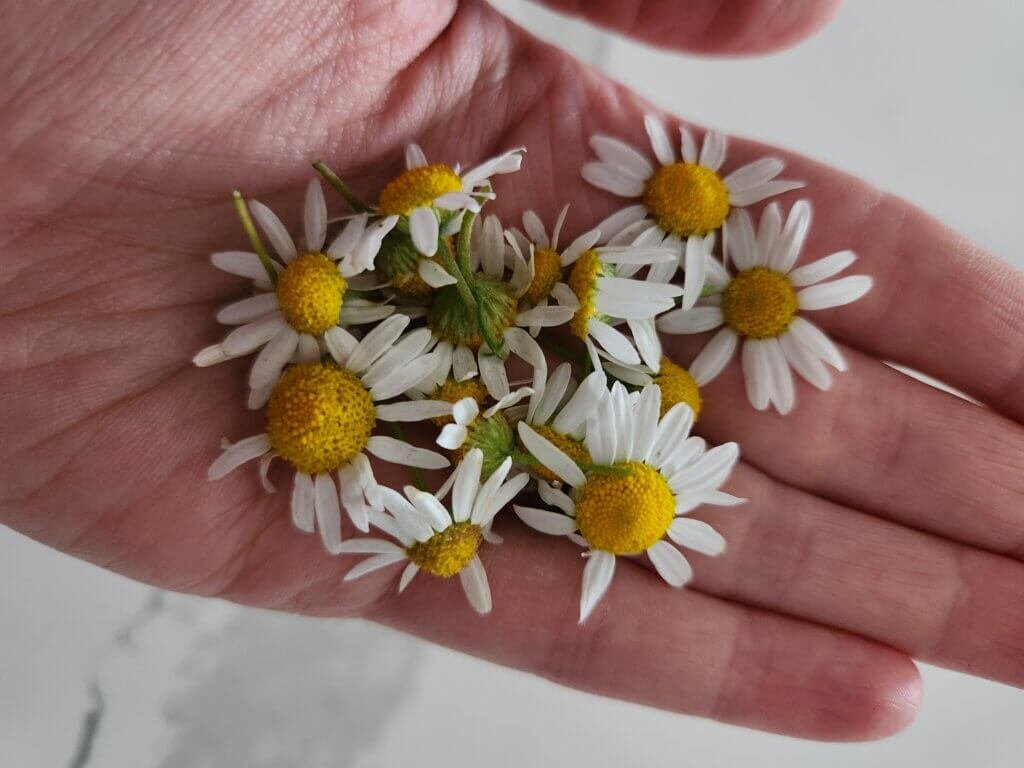
Advantages of Chamomile & Why To Grow Your Own
One of the greatest advantages of chamomile tea is that it supports both the body and mind naturally, all from a simple chamomile flower you can grow yourself.
Chamomile has been used for centuries as a natural remedy for stress, digestive issues, and skin irritation. Growing your own lets you enjoy these benefits straight from your garden – no store-bought teas required.
- Calming and Sleep Support: Chamomile tea helps reduce stress and promotes restful sleep. It’s a natura bedtime ritual that’s gentle enough for the whole family.
- Digestive Comfort: This herb is well known to sooth bloating, indigestion and mild stomach upset with a simple warm cup of tea.
- Skin and Hair Care: chamomile-infused water can calm irritated skin and reduce redness. It can even add a natural golden tint to light hair!
- Child-Safe Herb: Chamomile (along with herbs like dill) are extremely gentle, soothing and safe and healthy for children to consume as a tea or in bath soaks for a calming effort.
Chamomile and Pregnancy & Chamomile and Breastfeeding
Many people ask about chamomile and pregnancy or breastfeeding, and whether this calming tea is safe to enjoy. This gentle herb is well known for its mild, relaxing properties – making chamomile and pregnancy a safe combination for most women when enjoyed in moderation.
Chamomile and Pregnancy
This gentle herb is more than okay to consume while pregnant. It’s mild and tender properties will sooth your system and reduce cortisol levels. When mother’s are calm and stress free, so will be baby. Additionally, chamomile soothes any digestive upset (which pregnant women deal with a lot). Again the same benefits – calm mother equals a calm baby.
Chamomile and Breastfeeding
As explained already, chamomile is one of the gentlest herbs we know of. When chamomile advantages helps calm the mother, it also provides the added benefit of milk production. The more stressed a mother is, the harder it is on your body to produce milk. It’s important to keep as stress-free as possible during this time (which is almost impossible), so having a cup of chamomile tea with lavender or honey to calm the mother down, will only provide more benefits to the baby too.
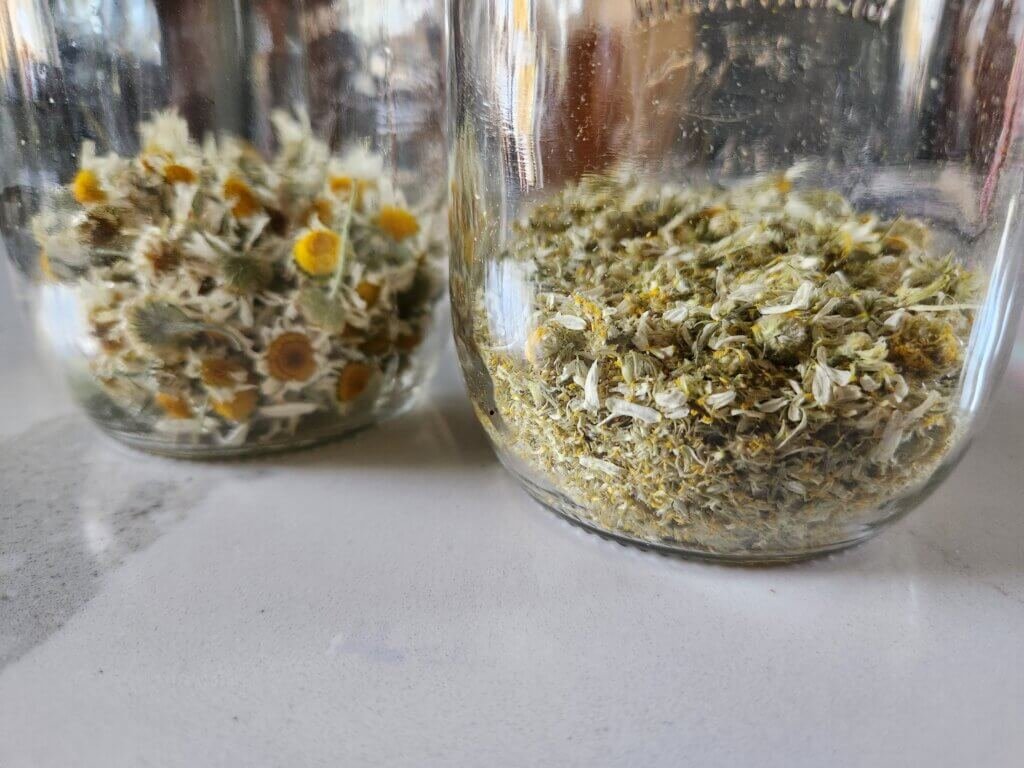
How to Grow Chamomile?
Growing chamomile is surprisingly low maintenance, making it a super easy herb to start from seed. Whether you’re planting chamomile flowers in your garden or a small pot indoors, here’s everything you need to know.
- Soil: Light, well-draining soil – avoid heavy clay.
- Sunlight: Full sun (6+ hours daily).
- Water: Water moderately; chamomile dislikes soggy soil.
- Spacing: 8–12 inches apart for airflow. For the low-ground cover perennial, it will keep growing outwards, so keep that in mind while planting.
- Fertilizer: Skip it! Chamomile prefers poorer soil.
When to Plant Chamomile in Zone 5 (Plan Ahead for Spring)
Planting chamomile is easy and best done in early spring once the soil can be worked. In Zone 5, this usually means late April to early May. Start planning your seed order now so you’re ready when spring arrives.
- German Chamomile (annual): Sow directly outdoors or start indoors 4–6 weeks before last frost.
- Roman Chamomile (perennial): Plant in well-drained soil and full sun; it will return each year.
- I currently grow this variety and it’s great. I love a good hardy perennial!
For gardeners wondering how to grow chamomile in colder climates like Zone 5, the key is timing and well-drained soil. Once established, this herb will reward you with a steady supply of fragrant chamomile flowers all summer long.
How to Harvest Chamomile?
The best time to harvest chamomile flowers is when they are fully open and fresh. Pick flowers regularly to encourage more blooms.
Rake your fingers through the little chamomile flowers and they will easily detach if ready with a gentle pull.
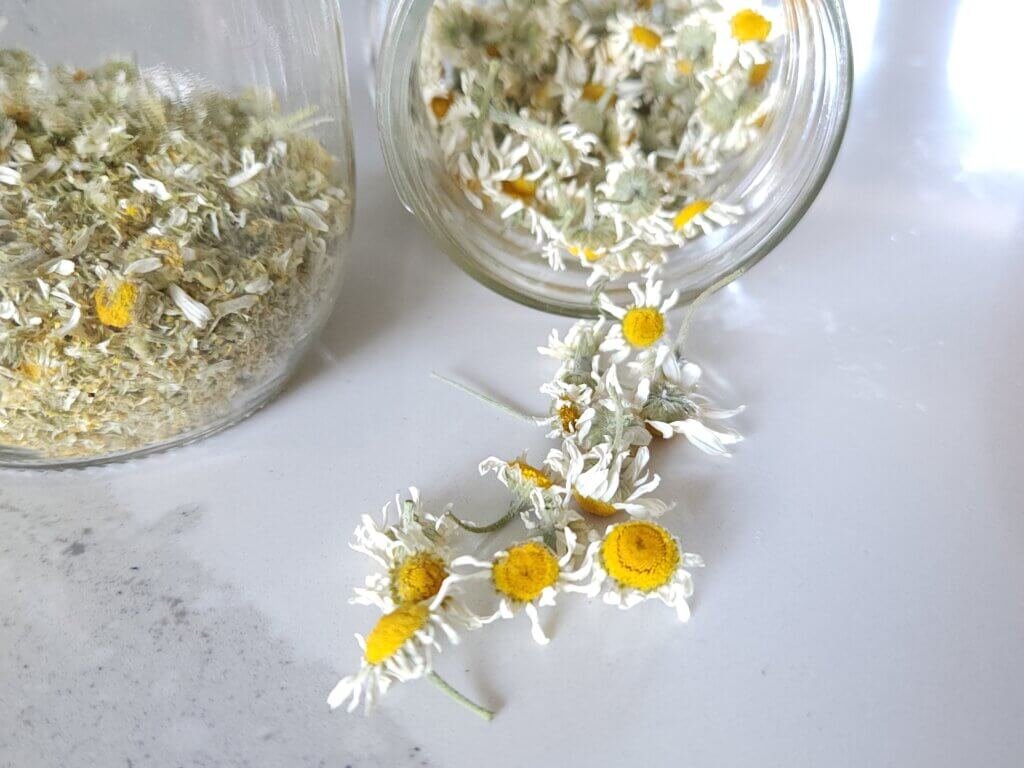
How to Dry Chamomile Flowers
To preserve your harvest:
- Spread flowers in a single layer on a mesh screen or paper towel.
- Keep them in a warm, dry, shaded area with good airflow.
- Stir occasionally until crisp and dry.
- Alternatively, place in a dehydrator 105F for 48 hours or until dry.
Store dried flowers in an airtight glass jar away from sunlight. They’ll stay fresh for up to a year.
How to Make Chamomile Tea?
Time needed: 15 minutes
Super simple and easy way to make traditional chamomile tea.
- Get Your Flowers
Simply gather as much or as little chamomile flower as you’d like and place in a loose left tea infuser. The more flower heads, the stronger your brew.
- Boil Water
Either in a kettle or in a pot on the stove, boil your water to your desired temperature
- Add boiled water to your flower
Add the boiled water to your tea cup with the tea bag inserted.
- Cover with a plate or lid to your cup
Covering your tea while it steeps will make for a stronger medicinal brew.
Cozy Fall & Winter Uses for Chamomile
Even when your garden sleeps, growing chamomile has lasting benefits through the colder months.
- Soothing evening tea – Brew with honey before bed.
- DIY herbal blends – Pair with lavender and lemon balm for a stress-relief mix.
- Winter skin care – Add to homemade bath soaks or facial steam.
- Cold-weather comfort – Infuse into syrups or make a tincture for seasonal wellness.
FAQ About Chamomile
Yes, it’s a best practice to deadhead the flowers you did not use so the plant can focus on new flower growth.
You can, but they have more of a bitter taste. Most people just don’t use them for that reason.
Yes! Chamomile grows well in pots or small containers on a sunny windowsill. Choose a container with drainage holes, use light potting soil, and trim regularly to keep plants compact. Indoor plants may not produce as many flowers as outdoor ones, but they’ll give you fresh tea herbs year-round.
Read More Herbs To Try
Conclusion: Why Every Gardener Should Grow Chamomile
Chamomile is the kind of plant that gives more than it takes – beautiful, useful, and endlessly calming. Whether you grow it for tea, wellness, or the simple joy of its scent, this gentle herb belongs in every garden. Grow it once, and you’ll never want to buy tea again.
Want to know more about medicinal herbs? Explore our Medicinal Herbs Hub for growing guides and natural remedies you can make at home. Don’t forget to join our newsletter for seasonal reminders and garden tips straight to your inbox!
We also have plenty of growing guides, seed saving guides and recipes. We are growing our website with more articles all the time, and we invite you to grow with us. If you have any questions about chamomile or would like to share some of your knowledge with us please leave a comment below. Happy Gardening!

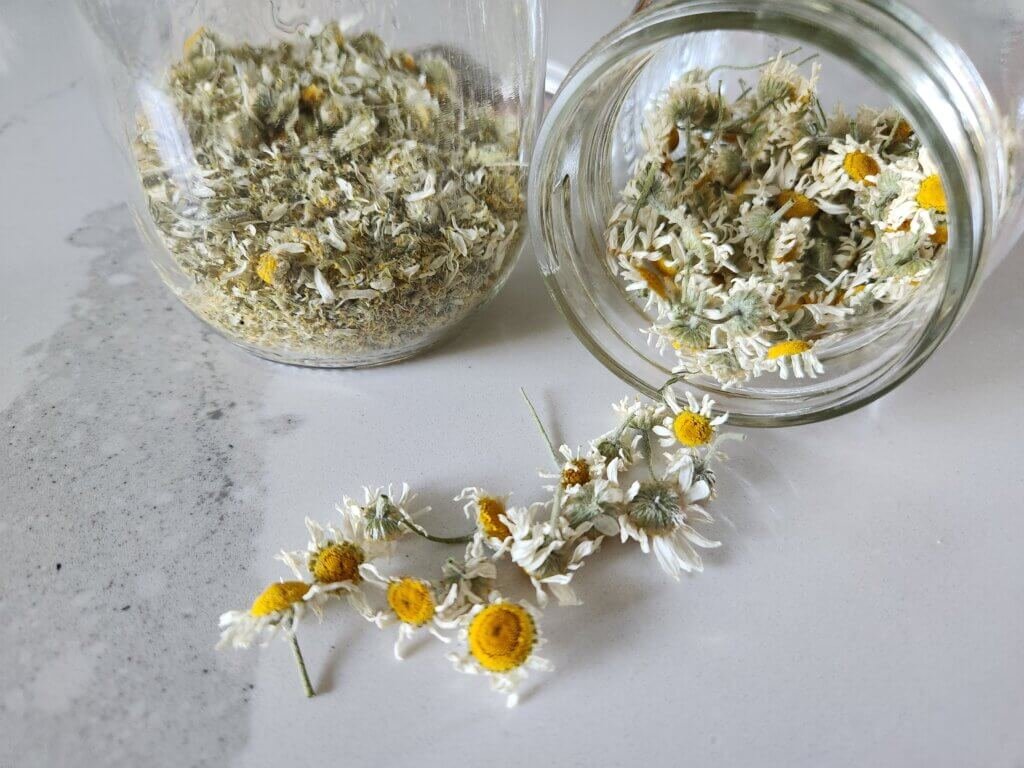

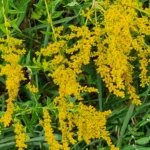
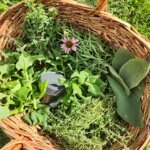
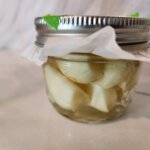
Would’ve never thought about something like this before, but this is great. Keep up the good work.
Thank you Ralph! Glad you were able to learn something new about chamomile! 🙂